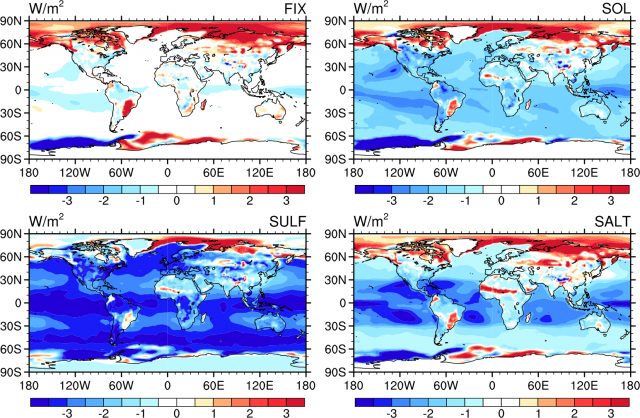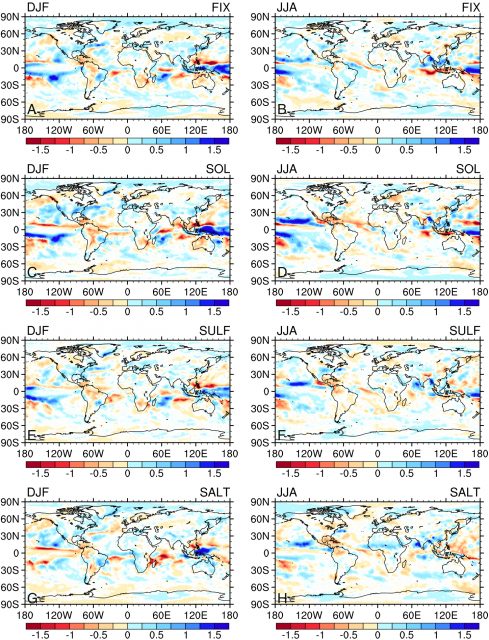Geoengineering versus Global Warming

Climate change due to global warming is usually presented as the Nemesis of our civilization. Day by day, evidences supporting temperature and sea level raise are presented. Numerical models point that CO2 concentration will lead to a new climate not very human friendly in what can be taken as the fastest ever climate change. Still, some decreasingly populated lobbies (science-based or not) deny the validity of the proofs and demand unbiased measurements and analysis. Whatever the case, real or not, it seems a good idea to search for a solution or a mitigation of the problem. Mitigation is the most commonly cited exit for a warming Earth and reducing the amount of carbon dioxide in the atmosphere is often presented and the one and only response for our caveats. But it is not, and, if the humankind dares doing it, there is another way: geoengineering.
In a letter to the editor of Nature magazine back in 1990 1, John Latham from the University of Manchester, proposed for the first time, as far as I am concerned, changing the cloud cover in order to change the energy budget of planet Earth. The idea is simple: if we get more energy than we need, why do not send it back to the space before it heats the atmosphere? The cloud cover is dominated to a great extent by the amount of available condensation nuclei, so maybe injecting sea salt or sulfur bearing nuclei (as volcanoes do) would be a solution for our problem.
As good as the idea was, it was just a compendium of back of the envelope calculations. A number of works developed the initial seed and introduced the perturbation into the fastly evolving climatological models. In 2006, an interesting work by Wigley, published in Science magazine, provided deep insights into geoengineering by introducing sulfur precursors in the atmosphere 2. The idea was mimicking a huge volcanic eruption, similar to the one at Mount Pinatubo in 1991. These aerosols provided the required negative feedback to counteract the heating produced by doubling the amount of CO2 in the atmosphere. The main result of this work was that half of the flux of sulfur produced by Pinatubo eruption (some 10 TgS, teragrams of sulfur) was needed every year in order to compensate the heating. However, it was still unclear how such a release would affect other climatic variables.
Leaving aside a number of works for the sake of brevity, we can highlight a work by Niemeier and collaborators in 2013 3. They explicitly mention the Solar Radiation Management (SRM) as a possible tools for geoengineering a progressively warmer Earth. One of the most striking features of this work is that they follow a benchmark in order to be able to compare a number of numerical experiments performed by different teams. Fulfilling a number of requisites in both the models and the a priori hypotheses allows a direct contrast of each modeling effort no matter how different from the others it is.
You can always balance the CO2 heating on the global means by introducing a term of the opposite sign. Reducing the amount of short wave radiation at the top of the atmosphere or at the surface will work, as Latham pointed out. But, and that’s the central problem, by doing so you might be altering the local equilibrium, or affecting the local rain regime. And that’s extremely important, since the ecology and human life is mostly determined locally and therefore we should be able to foresee all local and global consequences of our geoengineering before we even consider to use it.
The work by Niemeier et al. is focused in the SRM, in particular by simulating some ways of compensating greenhouse warming. The first way is placing mirrors at the Lagrangian point of our orbit, preventing the solar flux to reach the top of our atmosphere. Although it is not evident that such a method could be technically feasible or even economically affordable, it is a good way to prevent any sunlight to enter our atmosphere. The other methods act over our planet’s albedo; the first one by emitting sea salt over over the oceans, which increase marine stratocumulus formation, and the second one by increasing reflection from sea salt particles in clear sky conditions. Lastly, sulfur emission into the stratosphere is also considered. These three methods work at various atmospheric levels and that has an extraordinary influence in their side effects.

The first conclusion to note from this study is that the inertial in the climate system results in a increase of some 0.3K for the global mean temperature in the next 50 years whatever method we use to avoid the climatic change. This is in good agreement with results from others work (not necessarily related to geoengineering) and might mean that if we are about to do anything, other than let the climate go, we should start now.
From a more technical point of view, the main result of Niemeier and collaborators is the influence of each SRM technique on the hydrological cycle. There is a well known effect that happens when you increase the number of condesation nuclei: you get more clouds but the droplets are smaller and hence less likely to precipitate. This is a simple scheme but takes part of the physics. A complete modeling effort is more complex (as shown in Figure 3) and results in local increases or decreases of rainfall. It is not needed to mention the effect that this could have of human life. Some of the methods (sea salt emission), for example, increase precipitation over the land while decrease it over the oceans and may alter the equilibrium of the Walker circulation toward a prevailing La Niña situation.
In my opinion, this work is a good example of what we have test before we even consider the idea of altering the climate by geoengineering means. It has been discussed in other papers before that a sudden cancellation of any of these scenarios may result in a much sharper increase of temperature due to an over compensation effect. Whether we decide to do nothing, or to apply CO2 fixation techniques instead of solar radiation management, it is always a good idea to know as much as we can about the climatic response of Earth’s atmosphere. At least as far as our numerical models can go.

References
- J. Latham (1990). Control of global warming? Nature 347, 339 – 340, Scientific correspondence. doi:10.1038/347339b0 ↩
- T.M.L. Wigley (2006). A Combined Mitigation/Geoengineering Approach to Climate Stabilization . Science 314, 452 – 454. doi: 10.1126/science.1131728 ↩
- Niemeier et al Solar irradiance reduction via climate engineering: Impact of different techniques on the energy balance and the hydrological cycle, Journal of Geophysical Research: Atmospheres, 118 11905-11907. DOI: 10.1002/2013JD020445 ↩
5 comments
[…] Hurrengo mendean gizadiak aurre egin beharko dion erronka handiena bezala aurkezten da, berotze globalak eragindako klima-aldaketa. Orokorrean hau gutxitzeko aipatzen den ohikoena da, dioxido karbonoaren eta berotegi-efektua eragiten duten gainontzeko gasen isuri murrizketa, besterik ez balego bezala. Baina egon […]
[…] 2014/06/11: MI: Geoengineering versus Global Warming […]
[…] 2014/06/11: MI: Geoengineering versus Global Warming […]
[…] [Leer la entrada completa en Mapping Ignorance] […]
An interesting concept, but surely not a truly viable answer?
Environmental equilibrium is an extremly complex, chaotic manifestation of hundreds of factors.
It’s much simpler and vastly safer to undo an action that you know has disturbed that equilibrium, than to try to come up with a precisely targeted counter action, one that will do nothing else but offset your initial destabilising input.
Some examples of previous hubris:
Cane Toads, Kudzu, salination due to irrigation, gypsy moth caterpillars.